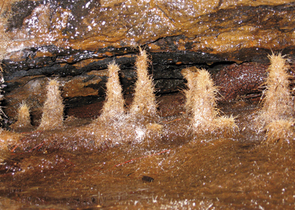Nature Conservation 2/2013 — 21. 6. 2013 — Nature and Landscape Management — Print article in pdf
Ouhrabka V. & Mlejnek R.: Caves in the National Parks in the Czech Republic

Karst and pseudokarst phenomena including many caves became an integrated part of abiotic nature in the National Parks (NPs) in the Czech Republic.
In the Krkonoše Mts. NP, there are 37 caves in carbonate rocks and 7 in non-karst rocks. The most important caves there include the Poniklá Cave (240 meters long) in the western part of the area and the longest cave in the Krkonoše Mts., the Albeřice Cave located on the NP’s eastern edge, reaching length of 250 meters. The pseudokarst Krakonoše’s Treasury, being 102 meters long, is a cave situated at the highest elevation in the Czech Republic (1,262 m a.s.l.). On the contrary, the Podyjí/Thaya River Basin NP is known due to a large number of caves in non-karst rocks (Bíteš orthogneiss). In a deep canyon-like valley formed by the meandering Dyje/Thaya River near the small town of Vranov nad Dyjí, there are suitable conditions for forming crevice caves. The term Ledové sluje/Ice Caves includes more than 20 individual caves. The complex six-storey system of the Brno Cave reaches in total length of 400 meters. In the Podyjí/Thaya River Basin NP, a few small caves were formed in carbonate rocks, providing palaeontologically valuable karst sediments. The Šumava/Bohemian Forest Mts. NP has not been fully examined for karst phenomena. Within the neighbouring Šumava/Bohemian Forest Mts. Protected Landscape Area, 15 karst caves are currently registered. Some of them were discovered during deep graphite mining activities at the Václav u Bližné Mine at the depth of approx. 65 meters below the ground surface. Caves in the České Švýcarsko/Bohemian Switzerland NP show quite different character, because they were formed in the classical sandstone pseudokarst there. They include broken, crevice and bedding-plane caves. In the area, a lot of caves have not been registered and documented yet. Caves in the NPs are also important from a point of view of biospeleology, because they provide shelters (hibernacula) for hibernating specially protected bats or suitable habitats for invertebrates. In addition, rare root forms occur there.

